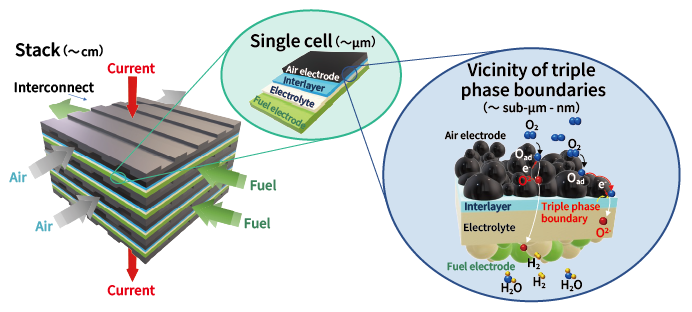Key Points
Solid oxide fuel cells (SOFCs) are already available for household and commercial use. Enhancing their performance and reducing costs will accelerate the realization of a carbon-neutral society. This research has achieved a world-record output density—10 times that of conventional SOFC single cells.
We interviewed Chief Senior Researcher Bagarinao Katherine from the Fundamental of Ionic Devices Research Team, Global Zero Emission Research Center, who received the AIST Paper Award for this study.
What makes this research amazingAchieved world-class performance in SOFC electrodes using unique composite materials!
Published in a high-impact international academic journal, gaining significant citations and worldwide attention.
Please tell us briefly about the result of this paper?
Katherine Bagarinao (hereafter, Bagarinao)“For this study, we took a completely new approach to create micro- to nanoscale fine structures. Using pulsed laser deposition (PLD) to deposit materials, we were able to create a never-before-seen stripe structure. Although composite materials for SOFC electrodes are being developed worldwide, their structures have always been random. When I first saw the striking nanostructure, I was amazed, and this structure ultimately led to the achievement of a world highest record of output density”.
 Structure of a solid oxide fuel cell (SOFC) cell stack and single cell
Structure of a solid oxide fuel cell (SOFC) cell stack and single cell
What did you keep in mind while working on your paper?
Bagarinao“We obtained the initial data around 2018. First, we applied for a patent before starting the paper. During the review process, we conducted additional experiments to address the reviewers’ comments. I thought deeply about what made our findings novel, what the unique aspects were, and what kind of story I could use to present the research. This was the most challenging yet exciting part. However, I was confident in the quality of our research, so I trusted my own experimental data while maintaining an objective perspective. I was very happy when our paper was finally accepted after peer review and revisions”.
Did the paper attract attention right after its publication?
Bagarinao“Our paper was published in 2021. Initially, we planned to present it at a conference, but due to the COVID-19 pandemic, we had to cancel. As a result, we were unsure who had read it or how it was received. However, citations have been increasing each year, and we are receiving more inquiries.
At an international conference held in Boston in 2023, many researchers from not only Europe and the U.S. but also Asia attended. I had the opportunity to interact with researchers for the first time, especially young researchers. I felt that people all over the world were interested in and concerned about the content of my presentation”.

I want people like you to know about thisThis study has gained significant attention from industry, academia, and the general public.
We envision new industry-academia collaborations and joint research, including cell stack development.
How is the research progressing at the moment?
Bagarinao“Until 2021, this research was conducted as part of the Advanced Solid Oxide Energy Conversion Consortium (ASEC), a joint project between AIST, eight companies, and four universities/research institutions. We are still receiving inquiries from energy companies and ceramic material manufacturers. There are still challenges to overcome in terms of implementation, and our current goal is to improve durability”.
In what fields do you expect to see developments and applications in the future?
Bagarinao“A single SOFC cell generate electricity by reacting hydrogen and oxygen. Conversely, we are also working on applying the technology to solid oxide electrolysis cells (SOEC), which use the same single cell to electrolyze water and carbon dioxide to produce hydrogen and carbon monoxide. The nanostructure contributes to the performance improvements not only in SOFCs but also in SOECs.
Europe is particularly advanced in hydrogen applications. Looking at international conferences and papers, there are many studies being published on the application of both SOFC and SOEC. By utilizing cutting-edge analytical technology, while also conducting joint research with overseas partners, we hope to continue working on materials and cell development that will lead the world in the forefront. Additionally, researchers from completely different fields have inquired about our nanostructures. We hope this technology can be widely applied beyond SOFCs and SOECs, leading to new collaborations”.
What kind of collaborations are you looking for?
Bagarinao“This research will truly contribute to solving social challenges when the single cell is integrated into a cell stack and implemented in real systems. We would like to work with companies that want to create a cell stack using single cells that can demonstrate the world's highest level of output density.
We need to think not only about the development of SOFC, but also about how to incorporate it into society so that it can be used as a system, and how to evaluate it. I would like to move forward towards the realization of a carbon neutral society together with companies that have a vision for development that takes into account everything from the fundamentals to applications”.
If you are interested in this research, please feel free to contact us!